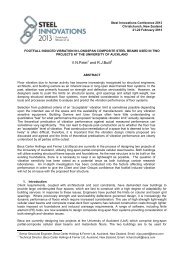Environmental Impacts of Multi-Storey Buildings Using Different ...
Environmental Impacts of Multi-Storey Buildings Using Different ...
Environmental Impacts of Multi-Storey Buildings Using Different ...
Create successful ePaper yourself
Turn your PDF publications into a flip-book with our unique Google optimized e-Paper software.
- 40 -A design feature <strong>of</strong> the Timber and TimberPlus buildings is prefabrication. The floors couldbe constructed from composite panels entirely prefabricated <strong>of</strong>f-site or by connecting concreteslabs prefabricated <strong>of</strong>f-site onto the timber joists and the adjacent slabs.An extensive experimental programme is currently ongoing at the University <strong>of</strong> Canterbury,New Zealand and the University <strong>of</strong> Technology, Sydney including tests to failure and longtermtests <strong>of</strong> full scale concrete-LVL composite beams and different connection details,dynamic vibration tests <strong>of</strong> composite beams, and tests under repeated loads <strong>of</strong> compositebeams and different connection details.The possibility <strong>of</strong> using pre-stressed LVL beams with composite connections to the concretetopping will also be investigated after good results <strong>of</strong> a preliminary study.4.4.3.2 Long-term EffectsDurabilityDurability has been a problem in multi-storey light-timber-frame buildings in New Zealand,with inadequate weather-pro<strong>of</strong>ing details leading to rapid decay <strong>of</strong> untreated timber studs inconcealed wall cavities. This problem is being solved with stringent new design andinspection procedures. There are also new requirements for using chemical treated timber instructural elements that may become wet due to weather exposure. Durability is not expectedto be a problem in the new commercial buildings using large scale beams, columns and walls,provided that attention is paid to weather-pro<strong>of</strong> cladding materials and the main structuralelements are visible for inspection.Creep testsAn extensive experimental programme aimed to investigate the long-term behaviour <strong>of</strong> prestressedLVL beams is currently in progress. The programme includes creep tests <strong>of</strong> smallLVL blocks, loaded in compression parallel and perpendicular to grain, creep tests <strong>of</strong> portions<strong>of</strong> two-bay LVL frames, where the beams are pre-stressed with unbonded tendons, and creeptests <strong>of</strong> LVL beams, with and without pre-stressing, subjected to gravity load. Preliminaryresults have shown a moderate (about 10%) reduction <strong>of</strong> pre-stressing force due to timedependentphenomena over one year. These results will be reported soon.Fire safetyThe fire safety aspects <strong>of</strong> multi-storey timber buildings is being assessed in accordance withNew Zealand and international codes, considering both internal and external growth andspread <strong>of</strong> fire, also structural fire resistance <strong>of</strong> the floors and main structural members. Since1992 the New Zealand Building Code has allowed timber buildings <strong>of</strong> unlimited heightprovided that performance requirements are met, whereas earlier codes limited height to onlythree storeys.
















